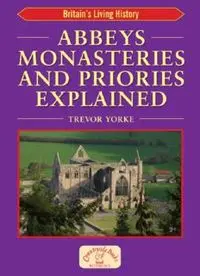
Abbeys Monasteries and Priories Explained. Britain's Living History PDF
Preview Abbeys Monasteries and Priories Explained. Britain's Living History
ABBEYS MONASTERIES AND PRIORIES EXPLAINED TREVOR YORKE COUNTRYSIDE BOOKS NEWBURY BERKSHIRE First published 2004 © Trevor Yorke 2004 Reprinted 2006 All rights reserved. No reproduction permitted without the prior permission of the publisher: COUNTRYSIDE BOOKS 3 Catherine Road Newbury, Berkshire To view our complete range of books. please visit us at www.countrysidebooks.co.uk ISBN 1 85306 854 3 Photographs and illustrations by the author Produced through MRM Associates Ltd., Reading Printed by Woolnough Bookbinding Ltd., Irthlingborough CONTENTS INTRODUCTION SECTION I THE HISTORY OF ABBEYS Chapter 1 DEFINITIONS AND ORIGINS Chapter 2 CELTIC AND SAXON MONASTERIES 500–1066 Chapter 3 NORMAN ABBEYS 1066–1200 Chapter 4 THE ABBEY AT ITS PEAK 1200–1350 Chapter 5 THE LATE MEDIEVAL ABBEY 1350–1536 Chapter 6 THE DISSOLUTION OF THE MONASTERIES AND THE FATE OF THE ABBEYS 1536 ONWARDS SECTION II THE ABBEY IN DETAIL Chapter 7 THE CHURCH Chapter 8 THE CLOISTER BUILDINGS Chapter 9 THE ABBEY PRECINCT Chapter 10 ABBEY ESTATES AND OTHER REMAINS IN THE LANDSCAPE SECTION III QUICK REFERENCE GUIDE TIME CHART ABBEYS AND PRIORIES TO VISIT GLOSSARY BIBLIOGRAPHY INDEX Introduction The medieval abbey or priory conjures up distinct images in our mind. Some may think of craggy ruins standing like broken teeth amongst fields or a grid of imposing stone walls laid out upon the bottom of some remote wooded valley. Others might imagine soaring cathedrals, a large number of which were once monasteries, or other great churches that still bear the title Abbey or Priory, revealing their medieval origin. Most, though, will picture hooded monks walking in silence around cloisters or standing with the shaved top of their heads exposed whilst chanting in the church choir. I have always found it frustrating to match my image of what a medieval abbey would have looked like with the fragmented remains that I can visit today. Some sites have only an information board to explain the ruins, while those with guidebooks often concentrate on character histories rather than the bewildering stonework that I have paid to see. The general publications available on the subject either tend to get bogged down with technical and historic details or are too lightweight, leaving questions unanswered and the features I see unexplained. It was with the intention of plugging the gap between too much information and too little that this series of books was born. Using my own drawings and diagrams, and photos taken from sites all over the country, The English Abbey Explained is an easy-to-understand guide designed to help you identify and understand the features you see when visiting these magnificent monuments. It is broken down into three sections, the first taking you on a historical journey from the origins of these buildings back in the days of the Roman Empire through to their dissolution by Henry VIII. It includes illustrations of their style and period details which may aid in identifying and dating structures, while at the end of each chapter there is a view of ‘Exemplar Abbey’, an imaginary site designed to give the reader a general idea of what these monasteries may have looked like in each period. The second section looks at the individual parts of an abbey, from the church and cloisters to the more mundane lavatories and drains, and explains how to recognise them and how they were used. The final part is a quick reference guide, including a time chart to help date buildings, a list of some of the best sites that are open to the public and a glossary explaining some of the more confusing terms that you may come across. Trevor Yorke CROXDEN ABBEY, STAFFORDSHIRE SECTION I THE HISTORY OF ABBEYS CHAPTER 1 Definitions and Origins Definitions Before looking into the history and features of abbeys, it is worth differentiating between the myriad of names that we associate with the subject. A religious house is a community of monks or nuns living together, more commonly called a convent when applied to the latter (but the term can be used for either sex). In most cases, therefore, a monastery is a religious house comprising monks, while a nunnery is a convent of nuns (it seems, though, that the word monastery is often applied to all types of religious houses and to both the community of monks and the buildings in which they live). The important words for the purposes of this book are abbey, which is a monastery or nunnery of large size or high status, and priory, which is a smaller house, often subordinate to an abbey, although some grew in size and status to become just as important. A friary is the home of friars, a later group who relied upon begging for their income and spent much of their time preaching in the outside world, as opposed to monks and nuns who resided almost permanently within their abbey or priory. Between these are canons, who are divided into two types: regular and secular. The former (from the word regula, meaning rule) lived like monks by strict monastic rules within their own abbey or priory, but unlike them also preached outside. Secular canons were not connected with monasteries and were usually associated with other religious establishments such as cathedrals and colleges. The principal member of the community was the abbot or abbess in an abbey and the prior or prioress in a priory, the latter often acting as deputies to their superiors at the abbey. Below these on the monastic social ladder were the obedientiaries, who were monks put in charge of the various departments of a monastery and typically named after them, like the cellarer, kitchener and infirmarer. Monasticism is divided into two forms: eremitic, where monks live an
